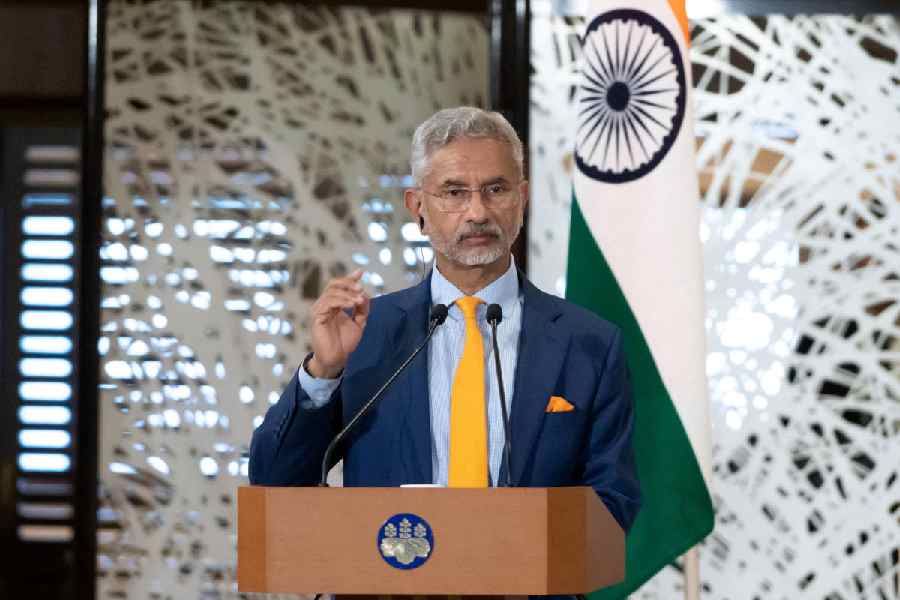External affairs minister S. Jaishankar on Monday claimed that India and China had come to an agreement on patrolling that allows a return to the 2020 situation along the Line of Actual Control, signalling the completion of the disengagement process with Beijing.
There was no immediate word from China on India’s claim, made first by foreign secretary Vikram Misri in response to a question at a briefing on Prime Minister Narendra Modi’s upcoming visit to Russia for the BRICS summit.
Later, addressing an NDTV conclave, Jaishankar said: “We reached an agreement on patrolling. We have gone back to where the situation was in 2020. And, we can say, with that the disengagement process with China has been completed. That’s as much as I can share with you.”
China has been accused of occupying about 1,000sqkm of India-claimed territory in Ladakh since May 2020, and the partial disengagements agreed before Monday’s announcements did not cover the Depsang Plains and Demchok.
Asked specifically whether Monday’s agreement would allow India to patrol areas in the Galwan Valley and the Depsang Plains, Jaishankar gave a vague answer.
“What has happened is that we have reached an understanding which will allow patrolling…. For example, Depsang — that’s not the only place, there are other places also. The understanding to my knowledge is that we will be able to do the patrolling which we were doing in 2020,” Jaishankar said.
The Chinese foreign ministry had on September 13 said the country’s troops had disengaged from four places, including the Galwan Valley, where a deadly clash in June 2020 left 20 Indian soldiers and several Chinese troops dead.
A day before the Chinese announcement on the Galwan Valley, Jaishankar had said in Geneva that about 75 per cent of the disengagement problems with China had been sorted out.
While Jaishankar described Monday’s development as “good” and “positive”, he was cautious about whether it would restore the bilateral relationship to the pre-2020 dynamic and improve trade and investment.
To a question on the development having a positive impact on bilateral trade and investment, he said: “It has just happened. There will now be meetings to see what should be the next steps. I wouldn’t go so fast.”
If the agreement holds, India believes it will help bring back peace and tranquillity to the border areas – which, New Delhi has insisted since the Galwan Valley clash, alone can restore normalcy to the bilateral relationship.
Earlier in the day, Misri broke the news of the agreement while responding to a question on whether Modi would meet Chinese President Xi Jinping on the sidelines of the BRICS Summit.
“Over the last several weeks, Indian and Chinese diplomatic and military negotiators have been in close contact with each other in a variety of forums,” he said.
“As a result of these discussions, agreement has been arrived at (regarding) patrolling arrangements along the LAC in the India-China border areas, leading to disengagement and a resolution of the issues that had arisen in these areas in 2020. We will be taking the next steps on this.”
The Indian army declined to comment on the foreign secretary’s statement. Sources, however, said a positive signal had come from the diplomatic side.
“Whenever we get the signal from the diplomatic side, the armies of both sides implement it on the ground based on the decisions taken by the two diplomatic sides,” an army official said.
The LAC has never been demarcated but both countries have had a perception of each other’s claim lines, based on decades of patrolling patterns.
Military veterans say the “Lines of Perception” are the notional boundaries up to which the troops of either side patrol. But status quo was altered in eastern Ladakh following multiple Chinese incursions in May 2020.
So far, there have been 21 rounds of military talks between the two armies to try and resolve the border standoff. During the talks – military and diplomatic -- India has been pressing for the restoration of the April 2020 position in terms of ground occupation and patrolling.
Jaishankar said the agreement had been achieved through patient and persevering diplomacy – “at various points of time people almost gave up”.
Yet, Prime Minister Modi had declared four days after the Galwan Valley clash in 2020 that no one had intruded into India or was occupying Indian territory, which allowed Beijing to deny any border transgressions and claim ownership of all the territory it held in the region. The Indian government too has since been maintaining that “India has not lost an inch of territory to China”.
Since then, corps commander-level talks between the two armies had achieved partial disengagement from multiple transgression points -- the Galwan Valley, Pangong Lake, Hot Springs and Gogra -- through the creation of “buffer zones” that neither army could patrol.
These zones were created with the Chinese and Indian armies stepping back by an agreed and equal distance each. This allegedly left the Chinese still within India-claimed lines while Indian soldiers retreated within their own territory, prompting military veterans to accuse India of “ceding more territory” to China through these disengagement agreements.
The two armies continue to deploy over 60,000 troops each, along with reinforced weaponry, along the LAC in eastern Ladakh.










